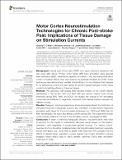| dc.contributor.author | O’Brien, Anthony T. | en_US |
| dc.contributor.author | Amorim, Rivadavio | en_US |
| dc.contributor.author | Rushmore, R. Jarrett | en_US |
| dc.contributor.author | Eden, Uri | en_US |
| dc.contributor.author | Afifi, Linda | en_US |
| dc.contributor.author | Dipietro, Laura | en_US |
| dc.contributor.author | Wagner, Timothy | en_US |
| dc.contributor.author | Valero-Cabré, Antoni | en_US |
| dc.date.accessioned | 2016-12-02T15:25:04Z | |
| dc.date.issued | 2016 | en_US |
| dc.identifier.citation | O’Brien, Anthony T., Rivadavio Amorim, R. Jarrett Rushmore, Uri Eden, Linda Afifi, Laura Dipietro, Timothy Wagner, and Antoni Valero-Cabré. 2016. “Motor Cortex Neurostimulation Technologies for Chronic Post-stroke Pain: Implications of Tissue Damage on Stimulation Currents.” Frontiers in Human Neuroscience 10 (1): 545. doi:10.3389/fnhum.2016.00545. http://dx.doi.org/10.3389/fnhum.2016.00545. | en |
| dc.identifier.issn | 1662-5161 | en |
| dc.identifier.uri | http://nrs.harvard.edu/urn-3:HUL.InstRepos:29626125 | |
| dc.description.abstract | Background: Central post stroke pain (CPSP) is a highly refractory syndrome that can occur after stroke. Primary motor cortex (M1) brain stimulation using epidural brain stimulation (EBS), transcranial magnetic stimulation (TMS), and transcranial direct current stimulation (tDCS) have been explored as potential therapies for CPSP. These techniques have demonstrated variable clinical efficacy. It is hypothesized that changes in the stimulating currents that are caused by stroke-induced changes in brain tissue conductivity limit the efficacy of these techniques. Methods: We generated MRI-guided finite element models of the current density distributions in the human head and brain with and without chronic focal cortical infarctions during EBS, TMS, and tDCS. We studied the change in the stimulating current density distributions’ magnitude, orientation, and maxima locations between the different models. Results: Changes in electrical properties at stroke boundaries altered the distribution of stimulation currents in magnitude, location, and orientation. Current density magnitude alterations were larger for the non-invasive techniques (i.e., tDCS and TMS) than for EBS. Nonetheless, the lesion also altered currents during EBS. The spatial shift of peak current density, relative to the size of the stimulation source, was largest for EBS. Conclusion: In order to maximize therapeutic efficiency, neurostimulation trials need to account for the impact of anatomically disrupted neural tissues on the location, orientation, and magnitude of exogenously applied currents. The relative current-neuronal structure should be considered when planning stimulation treatment, especially across techniques (e.g., using TMS to predict EBS response). We postulate that the effects of altered tissue properties in stroke regions may impact stimulation induced analgesic effects and/or lead to highly variable outcomes during brain stimulation treatments in CPSP. | en |
| dc.language.iso | en_US | en |
| dc.publisher | Frontiers Media S.A. | en |
| dc.relation.isversionof | doi:10.3389/fnhum.2016.00545 | en |
| dc.relation.hasversion | http://www.ncbi.nlm.nih.gov/pmc/articles/PMC5101829/pdf/ | en |
| dash.license | LAA | en_US |
| dc.subject | epidural brain stimulation | en |
| dc.subject | transcranial magnetic stimulation | en |
| dc.subject | transcranial direct current stimulation | en |
| dc.subject | motor cortex | en |
| dc.subject | neurological model | en |
| dc.subject | stroke | en |
| dc.subject | pain | en |
| dc.subject | analgesia | en |
| dc.title | Motor Cortex Neurostimulation Technologies for Chronic Post-stroke Pain: Implications of Tissue Damage on Stimulation Currents | en |
| dc.type | Journal Article | en_US |
| dc.description.version | Version of Record | en |
| dc.relation.journal | Frontiers in Human Neuroscience | en |
| dc.date.available | 2016-12-02T15:25:04Z | |
| dc.identifier.doi | 10.3389/fnhum.2016.00545 | * |


